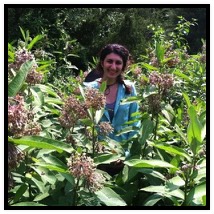Research Students

Sivan Yair
Connecting Herbivore Effects to Population Dynamics of Common Milkweed (Asclepias syriaca) Using an Integral Projection Model
Class of 2016
Thesis Abstract: Plant defense mechanisms and their effects on plant performance have been extensively studied in common milkweed (Asclepias syriaca). No studies, however, have investigated the relevance of these responses to its population dynamics. Common milkweed are clonal plants that exhibit both an induced defensive chemical response and mechanisms of resource allocation upon herbivore damage. Milkweed population decline has been implicated as a major contributing factor to the decline of monarch butterflies. We examined how herbivores affect the survival, growth, and fecundity of the ramets of common milkweed, and whether those effects were meaningful at the population level. By using an integral projection model to connect individual variation in size and foliar damage to population dynamics, we show that herbivores affect the milkweed's sexually reproductive output and clonal propagation, both pathways that the population growth rate is sensitive to. Our results provide insight on the herbivore effects that have greater influence on population growth and indicate future directions to improve the currently limited knowledge of how environmental factors drive population dynamics in common milkweed.
Thesis Link: http://publish.wm.edu/honorstheses/895/
Advisors: M. Drew LaMar and Harmony Dalgleish
Thesis Link: http://publish.wm.edu/honorstheses/895/
Advisors: M. Drew LaMar and Harmony Dalgleish

Scott Nordstrom
Spread of Adaptation and Migration Load in a Spatially Structured Population
Class of 2015
Thesis Abstract: Mercury contamination reduces fledging probability in birds. Mercury has been introduced to the South River in the Shenandoah, creating differences in habitat quality on a landscape of fragmented forest patches. To study the possible outcomes of the spread of this adaptation through populations in the Shenandoah, we construct and implement a mathematical model that features common life history traits, including dispersal and nest competition, of a generic bird species. To see which processes or parameters have the largest effect on allele frequencies, population sizes and reproductive output (a proxy for fitness), we use partial rank correlation. We conclude that in a simple two-patch instance of the model, local selection pressures and asymmetry of migration have the largest effects on allele frequencies and fitnesses. In half of cases observed, the mercury tolerance allele did not establish in either patch, but it did reach fixation in both patches in 20% of trials run. We also find that in a two-patch instance, allele frequencies in the contaminated and uncontaminated patches tend to correlate with each other very well, suggesting that there is a homogenizing process which couples allele frequencies.
Thesis Link: http://publish.wm.edu/honorstheses/188/
Advisors: M. Drew LaMar and Dan Cristol
Thesis Link: http://publish.wm.edu/honorstheses/188/
Advisors: M. Drew LaMar and Dan Cristol

Katherine Shipman
Measuring Cannibalism Rates in the Zooplankton Copepod Species, Acartia tonsa
Class of 2015
Thesis Abstract: Understanding the population dynamics of zooplankton is important to understanding the dynamics of the Chesapeake Bay, as zooplankton are at the interface of primary producers and higher trophic levels. Cannibalism is a potentially importance source of mortality for the copepod, Acartia tonsa, which is seasonally dominant in the Chesapeake Bay. In order to quantify cannibalistic behavior to improve terms and parameters in current zooplankton population models, I designed and conducted a two part experiment to measure cannibalism rates of A. tonsa. The experiments measured ingestion rates of phytoplankton, eggs and nauplii under varying starting concentrations of prey. Results were analyzed with 2-and 3-way ANOVAs and ingestion rates were fit with nonlinear Holling Type III models. This study adds to the current understanding of cannibalism in A. tonsa and highlights the need for further data collection.
Thesis Link: http://publish.wm.edu/honorstheses/175/
Advisors: M. Drew LaMar
Publications:
Catherine King, Kate Shipman, Sarah Day, and M. Drew LaMar, Dimension and mortality in linear stage class models of Acartia tonsa, Proceedings of the Sixth International Symposium on Biomathematics and Ecology: Education and Research, 2014.
Thesis Link: http://publish.wm.edu/honorstheses/175/
Advisors: M. Drew LaMar
Publications:
Catherine King, Kate Shipman, Sarah Day, and M. Drew LaMar, Dimension and mortality in linear stage class models of Acartia tonsa, Proceedings of the Sixth International Symposium on Biomathematics and Ecology: Education and Research, 2014.

Catherine King
Nonlinear Models of Zooplankton Communities
Class of 2014
Thesis Abstract: Modeling zooplankton dynamics accurately is increasingly important because zooplankton can have a critical impact on several environmental issues ranging from eutrophication to climate change. Because of the importance of zooplankton in marine ecosystems, there is a need to develop precise mathematical models. Most models, however, set zooplankton mortality as due to predation only. This approach is inaccurate as many zooplankton can die from non-predatory causes such as disease or starvation. Here we construct a model that includes both predatory and non-predatory zooplankton mortality rather than a linear differential equation model that relies on curve-fitting to data. Through MATLAB simulations, this theoretical nonlinear model was found to be a strongly contracting system even under certain amounts of stochastic influence. While a linear approach when modeling marine species is the natural first step, a nonlinear approach, which is based more on mathematical and ecological theories rather than curve-fitting, allows for more complicated and realistic dynamics in addition to more accurate predictions.
Thesis Link: http://publish.wm.edu/honorstheses/71/
Advisors: Sarah Day and M. Drew LaMar
Publications:
Catherine King, Kate Shipman, Sarah Day, and M. Drew LaMar, Dimension and mortality in linear stage class models of Acartia tonsa, Proceedings of the Sixth International Symposium on Biomathematics and Ecology: Education and Research, 2014.
Thesis Link: http://publish.wm.edu/honorstheses/71/
Advisors: Sarah Day and M. Drew LaMar
Publications:
Catherine King, Kate Shipman, Sarah Day, and M. Drew LaMar, Dimension and mortality in linear stage class models of Acartia tonsa, Proceedings of the Sixth International Symposium on Biomathematics and Ecology: Education and Research, 2014.

Sarah Gilliand
Population Modeling of Diamondback Terrapins
Class of 2014
Thesis Abstract: Diamondback terrapins are a species of turtle found along the coast of the United States from Massachusetts to Texas. Many of the states in this range list the terrapins as endangered, threatened, or a species of concern. However, little is known about their actual population sizes or dynamics. To address this, we use a nonlinear, stage-based model to examine the effects of human-related threats such as crab pots and road traffic. We compare our results to those produced by a linear model. When applied to a population of Rhode Island terrapins, our nonlinear model shows that crab potting has a larger negative effect on the population (which causes a population decline occurring at 6.6% mortality of affected stages) than road mortality (with a population decline at 10.6% mortality of affected stages). We also present population data gathered in the Williamsburg, VA area during the summer of 2013. We conclude that additional field work is needed in order to determine the status of many terrapin populations, but that in areas of existing crab potting, conservation efforts should focus on reducing terrapin mortality through the use of bycatch reduction devices.
Thesis Link: http://publish.wm.edu/honorstheses/24/
Advisors: M. Drew LaMar and Randy Chambers
Publications:
Sarah Gilliand, Randy Chambers, and M. Drew LaMar, Modeling the effects of crab potting and road traffic on a population of diamondback terrapins, Proceedings of the Sixth International Symposium on Biomathematics and Ecology: Education and Research, 2014.
Thesis Link: http://publish.wm.edu/honorstheses/24/
Advisors: M. Drew LaMar and Randy Chambers
Publications:
Sarah Gilliand, Randy Chambers, and M. Drew LaMar, Modeling the effects of crab potting and road traffic on a population of diamondback terrapins, Proceedings of the Sixth International Symposium on Biomathematics and Ecology: Education and Research, 2014.

Ryan Gryder
Basins of Attraction for Pulse-Coupled Oscillators
Class of 2014
Thesis Abstract: Basins of attraction for forward invariant sets can carve out portions of phase space where one can make predictions for asymptotic dynamics. We present com- putational algorithms for computing inner approximations of basins of attraction for discrete-time dynamical systems. The algorithms, based on subdivision tech- niques for grid construction and outer approximation of images, are adaptive and eciently allow one to identify full dimensional portions of phase space where the asymptotic dynamics may be described quantitatively. As illustration, we apply the techniques to a system of three pulse-coupled oscillators, computing an inner approximation for the basin of attraction for the synchronous (with all oscillators firing at the same time) steady state as well as a basin of attraction for a stable, non-synchronous steady state.
Thesis Link: http://publish.wm.edu/honorstheses/91/
Advisors: Sarah Day and M. Drew LaMar
Thesis Link: http://publish.wm.edu/honorstheses/91/
Advisors: Sarah Day and M. Drew LaMar

Sarah Kunkler
Finding the Minimum Randić Index
Class of 2012
Thesis Abstract: We show that finding a graph realization with the minimum Randic index for a given degree sequence is solvable in polynomial time. This is shown by reducing the problem to the minimum weight perfect b-matching problem. Using the b-matching problem, we find the realization with the minimum Randic index, but this graph is not guaranteed to be connected. In this case, we have developed a heuristic to connect the graph using two-switches, which preserves the degree sequence. From our experiments, the Randic index of the realization after our heuristic has a much lower percent difference from the minimum Randic index than that between the original and the minimum Randic index.
Thesis Link: http://publish.wm.edu/honorstheses/498/
Advisors: Rex Kincaid, David Phillips, and M. Drew LaMar
Publications:
Sarah J. Kunkler, M. Drew LaMar, Rex K. Kincaid, and David Phillips, Algorithms and complexity results for finding graphs with extremal Randić index, Networks (2016).
Thesis Link: http://publish.wm.edu/honorstheses/498/
Advisors: Rex Kincaid, David Phillips, and M. Drew LaMar
Publications:
Sarah J. Kunkler, M. Drew LaMar, Rex K. Kincaid, and David Phillips, Algorithms and complexity results for finding graphs with extremal Randić index, Networks (2016).

Allison Corish
Global Dynamics of Pulse-Coupled Oscillators
Class of 2012
Thesis Abstract: Networks of pulse-coupled oscillators can be used to model systems from firing neurons to blinking fireflies. Many past studies have focused on numerical simulations and locating the synchronous state of such systems. In this project, we construct a Poincare map for a system of three pulse-coupled oscillators and use rigorous computational techniques and topological tools to study both synchronous and asynchronous dynamics. We present sample results, including the computed basin of attraction for the synchronous state as well as a depiction of gradient-like dynamics in the remainder of the phase space. In the future, we hope to automate this process so that it can be applied to a wide range of network topologies and parameter values.
Thesis Link: http://publish.wm.edu/honorstheses/496/
Advisors: Sarah Day and M. Drew LaMar
Thesis Link: http://publish.wm.edu/honorstheses/496/
Advisors: Sarah Day and M. Drew LaMar

